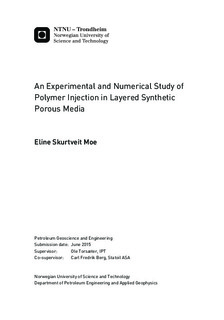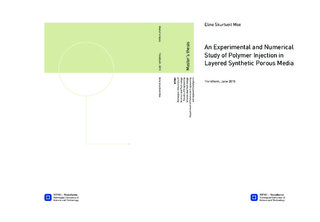| dc.description.abstract | In this Master thesis there was conducted polymer flooding of two-layered synthetic cores, where the two layers had different permeabilities, representing a stratified reservoir. The main purpose of this thesis was to investigate the crossflow within these layered porous media due to viscosity contrast of the injected fluids. It was tried to distinguish the separable effects of crossflow due to advection and diffusion. In particular it was desirable to find out if there was any significant diffusion of polymer between the two layers. A novel method was used to determine adsorption levels and inaccessible pore volumes within the layers of the cores.
The polymer used for the core floodings was a synthetic polymer named Flopaam 5115 SH. In addition, a tracer was added to the polymer solution. This tracer was an elevated salt content within the injected brine, compared to the saturating brine, so that it could be easily detected by a resistivity apparatus. The polymer production curve was determined by a pressure transducer connected to a coil. To investigate polymer diffusion within the cores they were shut in for two days after being flooded with polymer, allowing time for diffusion to act. They were then flooded with polymer again for a second time. At the beginning of the second polymer flood it should have been possible to see a change in the response of the production curve, if there had been a significant diffusion of polymer between the two layers during the two days the core was shut in. Numerical simulations were also run with different sensitivities, in order to get a better understanding of what had happened during the laboratory core flooding experiments.
The results showed that within the layered cores the high permeability layer was filled up with the injected fluid faster than the low permeability layer. Based on the numerical simulations and the experimental work it can be concluded that there were crossflow of the injected fluid from the high permeability layer to the low permeability layer. The crossflow between the layers of different permeabilities was mostly caused by viscous crossflow, both salt and polymer diffusion was negligible. Based on the sensitivity studies utilizing numerical simulation it seemed to be good fluid conductivity in the area between the two layers within the synthetic cores. Differences in adsorption time between the simulated and experimental cases is probably caused by the adsorption of polymer happening abruptly in the simulator, but during the flooding of the cores in the lab the polymer adsorption happened over time and were thus less concentrated at the flood front. A final concluding remark of this Master thesis is that doing experimental tests on synthetic two-layered cores can give interesting results for evaluation of polymer flooding. | |

